Metal Contents and Pollution Indices Assessment of Surface Water, Soil, and Sediment from the Arieș River Basin Mining Area, Romania
Abstract
:1. Introduction
2. Materials and Methods
2.1. Study Area
2.2. Sampling and Analytical Methods
2.3. Evaluation of Heavy-Metal Pollution
2.3.1. Assessment of Metal Water Pollution
2.3.2. Contamination and Ecological Risk Assessment of Soil and Sediment
2.4. Statistical and Visual Analysis
3. Results and Discussion
3.1. Surface-Water Samples
3.2. Surface Soils and Sediments
3.3. Statistical Analysis of Surface Water, Soil, and Sediments
3.4. Pollution Characteristics
4. Conclusions
Supplementary Materials
Author Contributions
Funding
Institutional Review Board Statement
Informed Consent Statement
Data Availability Statement
Acknowledgments
Conflicts of Interest
References
- Luckeneder, S.; Giljum, S.; Schaffartzik, A.; Maus, V.; Tost, M. Surge in global metal mining threatens vulnerable ecosystems. Glob. Environ. Change 2021, 69, 102303. [Google Scholar] [CrossRef]
- Li, G.; Lei, Y.; Ge, J.; Wu, S. The Empirical Relationship between Mining Industry Development and Environmental Pollution in China. Int. J. Environ. Res. Public Health 2017, 14, 254. [Google Scholar] [CrossRef] [PubMed] [Green Version]
- Pokhrel, L.R.; Dubey, B. Global Scenarios of Metal Mining, Environmental Repercussions, Public Policies, and Sustainability: A Review. Crit. Rev. Environ. Sci. Technol. 2013, 43, 2352–2388. [Google Scholar] [CrossRef]
- Sun, Z.; Xie, X.; Wang, P.; Hu, Y.; Cheng, H. Heavy metal pollution caused by small-scale metal ore mining activities: A case study from a polymetallic mine in South China. Sci. Total Environ. 2018, 639, 217–227. [Google Scholar] [CrossRef]
- Abraham, M.R.; Susan, T.B. Water contamination with heavy metals and trace elements from Kilembe copper mine and tailing sites in Western Uganda; implications for domestic water quality. Chemosphere 2017, 169, 281–287. [Google Scholar] [CrossRef] [PubMed]
- Li, Z.; Ma, Z.; van der Kuijp, T.J.; Yuan, Z.; Huang, L. A review of soil heavy metal pollution from mines in China: Pollution and health risk assessment. Sci. Total Environ. 2014, 468–469, 843–853. [Google Scholar] [CrossRef] [PubMed]
- Jaskuła, J.; Sojka, M. Assessment of spatial distribution of sediment contamination with heavy metals in the two biggest rivers in Poland. Catena 2022, 211, 105959. [Google Scholar] [CrossRef]
- Tchounwou, P.B.; Yedjou, C.G.; Patlolla, A.K.; Sutton, D.J. Heavy Metal Toxicity and the Environment. In Molecular, Clinical and Environmental Toxicology: Volume 3: Environmental Toxicology; Luch, A., Ed.; Springer: Basel, Switzerland, 2012; pp. 133–164. [Google Scholar] [CrossRef] [Green Version]
- Ali, H.; Khan, E.; Ilahi, I. Environmental Chemistry and Ecotoxicology of Hazardous Heavy Metals: Environmental Persistence, Toxicity, and Bioaccumulation. J. Chem. 2019, 2019, 6730305. [Google Scholar] [CrossRef] [Green Version]
- Zhuang, Q.; Li, G.; Liu, Z. Distribution, source and pollution level of heavy metals in river sediments from South China. Catena 2018, 170, 386–396. [Google Scholar] [CrossRef]
- Iordache, A.M.; Nechita, C.; Zgavarogea, R.; Voica, C.; Varlam, M.; Ionete, R.E. Accumulation and ecotoxicological risk assessment of heavy metals in surface sediments of the Olt River, Romania. Sci. Rep. 2022, 12, 880. [Google Scholar] [CrossRef]
- Xie, Y.; Fan, J.; Zhu, W.; Amombo, E.; Lou, Y.; Chen, L.; Fu, J. Effect of Heavy Metals Pollution on Soil Microbial Diversity and Bermudagrass Genetic Variation. Front. Plant Sci. 2016, 7, 755. [Google Scholar] [CrossRef] [PubMed]
- Fazekašová, D.; Fazekaš, J. Soil Quality and Heavy Metal Pollution Assessment of Iron Ore Mines in Nizna Slana (Slovakia). Sustainability 2020, 12, 2549. [Google Scholar] [CrossRef] [Green Version]
- Hinsinger, P.; Plassard, C.; Jaillard, B. Rhizosphere: A new frontier for soil biogeochemistry. J. Geochem. Explor. 2006, 88, 210–213. [Google Scholar] [CrossRef]
- Kumar, V.; Parihar, R.D.; Sharma, A.; Bakshi, P.; Singh Sidhu, G.P.; Bali, A.S.; Karaouzas, I.; Bhardwaj, R.; Thukral, A.K.; Gyasi-Agyei, Y.; et al. Global evaluation of heavy metal content in surface water bodies: A meta-analysis using heavy metal pollution indices and multivariate statistical analyses. Chemosphere 2019, 236, 124364. [Google Scholar] [CrossRef] [PubMed]
- Karaouzas, I.; Kapetanaki, N.; Mentzafou, A.; Kanellopoulos, T.D.; Skoulikidis, N. Heavy metal contamination status in Greek surface waters: A review with application and evaluation of pollution indices. Chemosphere 2021, 263, 128192. [Google Scholar] [CrossRef] [PubMed]
- Kowalska, J.B.; Mazurek, R.; Gąsiorek, M.; Zaleski, T. Pollution indices as useful tools for the comprehensive evaluation of the degree of soil contamination—A review. Environ. Geochem. Health 2018, 40, 2395–2420. [Google Scholar] [CrossRef] [Green Version]
- Nawrot, N.; Wojciechowska, E.; Mohsin, M.; Kuittinen, S.; Pappinen, A.; Rezania, S. Trace Metal Contamination of Bottom Sediments: A Review of Assessment MeasuRes. and Geochemical Background Determination Methods. Minerals 2021, 11, 872. [Google Scholar] [CrossRef]
- Dung, T.T.T.; Cappuyns, V.; Swennen, R.; Phung, N.K. From geochemical background determination to pollution assessment of heavy metals in sediments and soils. Rev. Environ. Sci. Biotechnol. 2013, 12, 335–353. [Google Scholar] [CrossRef]
- Forray, F.L.; Hallbauer, D.K. A study of the pollution of the Aries River (Romania) using capillary electrophoresis as analytical technique. Environ. Geol. 2000, 39, 1372–1384. [Google Scholar] [CrossRef]
- Bird, G.; Brewer, P.A.; Macklin, M.G.; Serban, M.; Balteanu, D.; Driga, B. Heavy metal contamination in the Arieş river catchment, western Romania: Implications for development of the Roşia Montană gold deposit. J. Geochem. Explor. 2005, 86, 26–48. [Google Scholar] [CrossRef]
- Levei, E.; Ponta, M.; Senila, M.; Miclean, M.; Frentiu, T. Assessment of contamination and origin of metals in mining affected river sediments: A case study of the Aries catchment, Romania. J. Serb. Chem. Soc. 2014, 79, 1019–1036. [Google Scholar] [CrossRef]
- Moldovan, A.; Hoaghia, M.-A.; Török, A.I.; Roman, M.; Mirea, I.C.; Barabas, R.; Micle, V.; Cadar, O. Spatial Variation of Water Chemistry in Aries River Catchment, Western Romania. Appl. Sci. 2021, 11, 6592. [Google Scholar] [CrossRef]
- European Soil Data Centre (ESDAC), European Commission, JoInt. Research Centre. Available online: https://esdac.jrc.ec.europa.eu/ (accessed on 12 April 2022).
- Bănăduc, D.; Curtean-Bănăduc, A.; Cianfaglione, K.; Akeroyd, J.R.; Cioca, L.-I. Proposed Environmental Risk Management Elements in a Carpathian Valley Basin, within the Roşia Montană European Historical Mining Area. Int. J. Environ. Res. Public Health 2021, 18, 4565. [Google Scholar] [CrossRef]
- Brad, T.; Bizic, M.; Ionescu, D.; Chiriac, C.M.; Kenesz, M.; Roba, C.; Ionescu, A.; Fekete, A.; Mirea, I.C.; Moldovan, O.T. Potential for Natural Attenuation of Domestic and Agricultural Pollution in Karst Groundwater Environments. Water 2022, 14, 1597. [Google Scholar] [CrossRef]
- Friedel, M.J.; Tindall, J.A.; Sardan, D.; Fey, D.; Poptua, G.L. Reconnaissance Study of Water Quality in the Mining-Affected Aries River Basin, Romania; U.S. Geological Survey Open-File Report; U.S. Geological Survey: Reston, VA, USA, 2008; p. 40.
- Fontanine, I.; Costache, R. The potential for water diffuse pollution with heavy metals in Arieș river basin. An. Stiint. Univ. Alexandru Ioan Cuza Din Iasi-Ser. Geogr. 2013, 59, 59–72. [Google Scholar]
- Cadar, O.; Dinca, Z.; Senila, M.; Torok, A.I.; Todor, F.; Levei, E.A. Immobilization of Potentially Toxic Elements in Contaminated Soils Using Thermally Treated Natural Zeolite. Materials 2021, 14, 3777. [Google Scholar] [CrossRef]
- Senila, M.; Cadar, O.; Senila, L.; Hoaghia, A.; Miu, I. Mercury Determination in Natural Zeolites by Thermal Decomposition Atomic Absorption Spectrometry: Method Validation in Compliance with Requirements for Use as Dietary Supplements. Molecules 2019, 24, 4023. [Google Scholar] [CrossRef] [Green Version]
- Abdel-Satar, A.M.; Ali, M.H.; Goher, M.E. Indices of water quality and metal pollution of Nile River, Egypt. Egypt. J. Aquat. Res. 2017, 43, 21–29. [Google Scholar] [CrossRef]
- Setia, R.; Dhaliwal, S.S.; Kumar, V.; Singh, R.; Kukal, S.S.; Pateriya, B. Impact assessment of metal contamination in surface water of SutleJ. River (India) on human health risks. Environ. Pollut. 2020, 265, 114907. [Google Scholar] [CrossRef]
- Tokatlı, C.; Varol, M. Impact of the COVID-19 lockdown period on surface water quality in the Meriç-Ergene River Basin, Northwest Turkey. Environ. Res. 2021, 197, 111051. [Google Scholar] [CrossRef]
- Directive 2008/32/EC of the European Parliament and of the Council of 11 March 2008 Amending Directive 2000/60/EC Establishing a Framework for Community Action in the Field of Water Policy, as Regards the Implementing Powers Conferred on the Commission. Available online: https://eur-lex.europa.eu/legal-content/EN/ALL/?uri=celex:32008L0032 (accessed on 15 April 2022).
- Order No. 161 for the Approval of the Norm Regarding the Classification of Surface Water Quality in Order to Establish the Ecological Status of Water Bodies. Available online: http://www.monitoruljuridic.ro/monitorul-oficial/161/2006-02-21 (accessed on 15 April 2022).
- Edet, A.E.; Offiong, O.E. Evaluation of water quality pollution indices for heavy metal contamination monitoring. A study case from Akpabuyo-Odukpani area, Lower Cross River Basin (southeastern Nigeria). GeoJ. 2002, 57, 295–304. [Google Scholar] [CrossRef]
- Shil, S.; Singh, U.K. Health risk assessment and spatial variations of dissolved heavy metals and metalloids in a tropical river basin system. Ecol. Indic. 2019, 106, 105455. [Google Scholar] [CrossRef]
- Varol, M.; Tokatlı, C. Impact of paddy fields on water quality of Gala Lake (Turkey): An important migratory bird stopover habitat. Environ. Pollut. 2021, 287, 117640. [Google Scholar] [CrossRef] [PubMed]
- Rezaei, A.; Hassani, H.; Hassani, S.; Jabbari, N.; Fard Mousavi, S.B.; Rezaei, S. Evaluation of groundwater quality and heavy metal pollution indices in Bazman basin, southeastern Iran. Groundw. Sustain. Dev. 2019, 9, 100245. [Google Scholar] [CrossRef]
- Fagbenro, A.A.; Yinusa, T.S.; Ajekiigbe, K.M.; Oke, A.O.; Obiajunwa, E.I. Assessment of heavy metal pollution in soil samples from a gold mining area in Osun State, Nigeria using proton-induced X-ray emission. Sci. Afr. 2021, 14, e01047. [Google Scholar] [CrossRef]
- Taylor, S.R.; McLennan, S.M. The geochemical evolution of the continental crust. Rev. Geophys. 1995, 33, 241–265. [Google Scholar] [CrossRef]
- Hakanson, L. An ecological risk index for aquatic pollution control.a sedimentological approach. Water Res. 1980, 14, 975–1001. [Google Scholar] [CrossRef]
- Varol, M.; Gündüz, K.; Sünbül, M.R. Pollution status, potential sources and health risk assessment of arsenic and trace metals in agricultural soils: A case study in Malatya province, Turkey. Environ. Res. 2021, 202, 111806. [Google Scholar] [CrossRef]
- Alharbi, T.; El-Sorogy, A.S. Spatial distribution and risk assessment of heavy metals pollution in soils of marine origin in central Saudi Arabia. Mar. Pollut. Bull 2021, 170, 112605. [Google Scholar] [CrossRef]
- Negrin, V.L.; Idaszkin, Y.L.; Domini, C.; Simonetti, P.; Botté, S.E. Soil metal pollution assessment in Sarcocornia salt marshes in a South American estuary. Mar. Pollut. Bull 2021, 166, 112224. [Google Scholar] [CrossRef]
- Yan, T.; Zhao, W.; Yu, X.; Li, H.; Gao, Z.; Ding, M.; Yue, J. Evaluating heavy metal pollution and potential risk of soil around a coal mining region of Tai’an City, China. Alex. Eng. J. 2022, 61, 2156–2165. [Google Scholar] [CrossRef]
- Kumar, V.; Pandita, S.; Setia, R. A meta-analysis of potential ecological risk evaluation of heavy metals in sediments and soils. Gondwana Res. 2022, 103, 487–501. [Google Scholar] [CrossRef]
- Yi, Y.; Yang, Z.; Zhang, S. Ecological risk assessment of heavy metals in sediment and human health risk assessment of heavy metals in fishes in the middle and lower reaches of the Yangtze River basin. Environ. Pollut. 2011, 159, 2575–2585. [Google Scholar] [CrossRef] [PubMed]
- Zhai, Y.Z.; Cao, X.Y.; Xia, X.L.; Wang, B.; Teng, Y.G.; Li, X. Elevated Fe and Mn Concentrations in Groundwater in the Songnen Plain, Northeast China, and the Factors and Mechanisms Involved. Agronomy 2021, 11, 2392. [Google Scholar] [CrossRef]
- Hem, J.D. Chemical Equilibria Affecting the Behavior of Manganese in Natural Water. Int. Assoc. Sci. Hydrol. Bull. 1963, 8, 30–37. [Google Scholar] [CrossRef]
- Howe, P.D.; Mal-Colm, H.M.; Dobson, S. Manganese and Its Compounds: Environmental Aspects; World Health Organization & International Programme on Chemical Safety: Geneva, Switzerland, 2004. [Google Scholar]
- Neculita, C.M.; Rosa, E. A review of the implications and challenges of manganese removal from mine drainage. Chemosphere 2019, 214, 491–510. [Google Scholar] [CrossRef] [PubMed]
- Zwolak, A.; Sarzyńska, M.; Szpyrka, E.; Stawarczyk, K. Sources of Soil Pollution by Heavy Metals and Their Accumulation in Vegetables: A Review. Water Air. Soil. Pollut. 2019, 230, 164. [Google Scholar] [CrossRef] [Green Version]
- Lu, J.; Lu, H.; Wang, W.; Feng, S.; Lei, K. Ecological risk assessment of heavy metal contamination of mining area soil based on land type changes: An information network environ analysis. Ecol. Model. 2021, 455, 109633. [Google Scholar] [CrossRef]
- Ministry of Water, Forest and Environmental Protection. Order, no. 184 of 21 1997 for the Approval of the Procedure for Performing Environmental Calculations. Official Publication no. 303-bis of November 6. Available online: https://legislatie.just.ro/Public/DetaliiDocument/13572 (accessed on 12 April 2022).
- Liu, H.; Liu, E.; Yu, Z.; Lin, Q.; Zhang, E.; Shen, J. Spatio-temporal accumulation patterns of trace metals in sediments of a large plateau lake (Erhai) in Southwest China and their relationship with human activities over the past century. J. Geochem. Explor. 2022, 234, 106943. [Google Scholar] [CrossRef]
- Hoaghia, M.A.; Cadar, O.; Moisa, C.; Roman, C.; Kovacs, E. Heavy metals and health risk assessment in vegetables grown in the vicinity of a former non-metallic facility located in Romania. Environ. Sci. Pollut. Res. Int. 2022, 29, 40079–40093. [Google Scholar] [CrossRef]
- Levei, E.; Frentiu, T.; Ponta, M.; Tanaselia, C.; Borodi, G. Characterization and assessment of potential environmental risk of tailings stored in seven impoundments in the Aries river basin, Western Romania. Chem. Cent. J. 2013, 7, 5. [Google Scholar] [CrossRef] [PubMed] [Green Version]
- Wu, W.; Qu, S.; Nel, W.; Ji, J. The impact of natural weathering and mining on heavy metal accumulation in the karst areas of the Pearl River Basin, China. Sci. Total Environ. 2020, 734, 139480. [Google Scholar] [CrossRef] [PubMed]
- Liu, W.S.; Guo, M.N.; Liu, C.; Yuan, M.; Chen, X.T.; Huot, H.; Zhao, C.M.; Tang, Y.T.; Morel, J.L.; Qiu, R.L. Water, sediment and agricultural soil contamination from an ion-adsorption rare earth mining area. Chemosphere 2019, 216, 75–83. [Google Scholar] [CrossRef] [PubMed]
- Butiuc-Keul, A.; Momeu, L.; Craciunas, C.; Dobrota, C.; Cuna, S.; Balas, G. Physico-chemical and biological studies on water from Aries River (Romania). J. Environ. Manag. 2012, 95, S3–S8. [Google Scholar] [CrossRef]
- Levei, E.; Senila, M.; Miclean, M.; Abraham, B.; Roman, C.; Stefanescu, L.; Moldovan, O.T. Influence of Rosia Poieni and Rosia Montana Mining Areas on the Water Quality of the Aries River. Environ. Eng. Manag. J. 2011, 10, 23–29. [Google Scholar] [CrossRef]
- Senila, M.; Levei, E.A.; Senila, L.R.; Roman, M. Preliminary Investigation concerning Metals Bioavailability in Waters of Aries River Catchment by Using the Diffusive Gradients in Thin Films Technique. J. Chem. 2015, 2015, 762121. [Google Scholar] [CrossRef]
- Whitehead, P.G.; Butterfield, D.; Wade, A.J. Simulating metals and mine discharges in river basins using a new integrated catchment model for metals: Pollution impacts and restoration strategies in the Aries-MuRes. river system in Transylvania, Romania. Hydrol. Res. 2009, 40, 323–346. [Google Scholar] [CrossRef]
- Bodoczi, A.; Carpa, R. The quantitative variation of some ecophysiological group of bacteria from Arieş River sediments affected by pollution. Carpathian J. Earth Environ. Sci. 2010, 5, 145–152. [Google Scholar]
- Moldovan, O.T.; Meleg, I.N.; Levei, E.; Terente, M. A simple method for assessing biotic indicators and predicting biodiversity in the hyporheic zone of a river polluted with metals. Ecol. Indic. 2013, 24, 412–420. [Google Scholar] [CrossRef]
- Neamtiu, I.A.; Al-Abed, S.R.; McKernan, J.L.; Baciu, C.L.; Gurzau, E.S.; Pogacean, A.O.; Bessler, S.M. Metal contamination in environmental media in residential areas around Romanian mining sites. Rev. Environ. Health 2017, 32, 215–220. [Google Scholar] [CrossRef]
- Suciu, I.; Cosma, C.; Todica, M.; Bolboaca, S.D.; Jantschi, L. Analysis of soil heavy metal pollution and pattern in central transylvania. Int. J. Mol. Sci. 2008, 9, 434–453. [Google Scholar] [CrossRef] [PubMed] [Green Version]
- Moldovan, A.; Török, A.I.; Cadar, O.; Roman, M.; Roman, C.; Micle, V. Assessment of toxic elements contamination in surface water and sediments in a mining affected area. Stud. Univ. Babeş-Bolyai Chem. 2021, 66, 189–196. [Google Scholar] [CrossRef]
- Corcheş, M.T. A study of the natural pollution of the Aries River. J. Agroaliment. Process. Technol. 2011, 17, 330–334. [Google Scholar]
- Tytla, M. Assessment of Heavy Metal Pollution and Potential Ecological Risk in Sewage Sludge from Municipal Wastewater Treatment Plant Located in the Most Industrialized Region in Poland-Case Study. Int. J. Environ. Res. Public Health 2019, 16, 2430. [Google Scholar] [CrossRef] [PubMed] [Green Version]
- Tytla, M. Identification of the Chemical Forms of Heavy Metals in Municipal Sewage Sludge as a Critical Element of Ecological Risk Assessment in Terms of Its Agricultural or Natural Use. Int. J. Environ. Res. Public Health 2020, 17, 4640. [Google Scholar] [CrossRef]
- Tytla, M.; Widziewicz, K.; Zielewicz, E. Heavy metals and its chemical speciation in sewage sludge at different stages of processing. Environ. Technol. 2016, 37, 899–908. [Google Scholar] [CrossRef]
- Wang, C.; Hu, X.; Chen, M.L.; Wu, Y.H. Total concentrations and fractions of Cd, Cr, Pb, Cu, Ni and Zn in sewage sludge from municipal and industrial wastewater treatment plants. J. Hazard. Mater 2005, 119, 245–249. [Google Scholar] [CrossRef]
- Arisekar, U.; Shakila, R.J.; Shalini, R.; Jeyasekaran, G.; Keerthana, M.; Arumugam, N.; Almansour, A.I.; Perumal, K. Distribution and ecological risk assessment of heavy metals using geochemical normalization factors in the aquatic sediments. Chemosphere 2022, 294, 133708. [Google Scholar] [CrossRef]
- El Fadili, H.; Ben Ali, M.; Touach, N.; El Mahi, M.; Mostapha Lotfi, E. Ecotoxicological and pre-remedial risk assessment of heavy metals in municipal solid wastes dumpsite impacted soil in morocco. Environ. Nanotechnol. Monit. Manag. 2022, 17, 100640. [Google Scholar] [CrossRef]


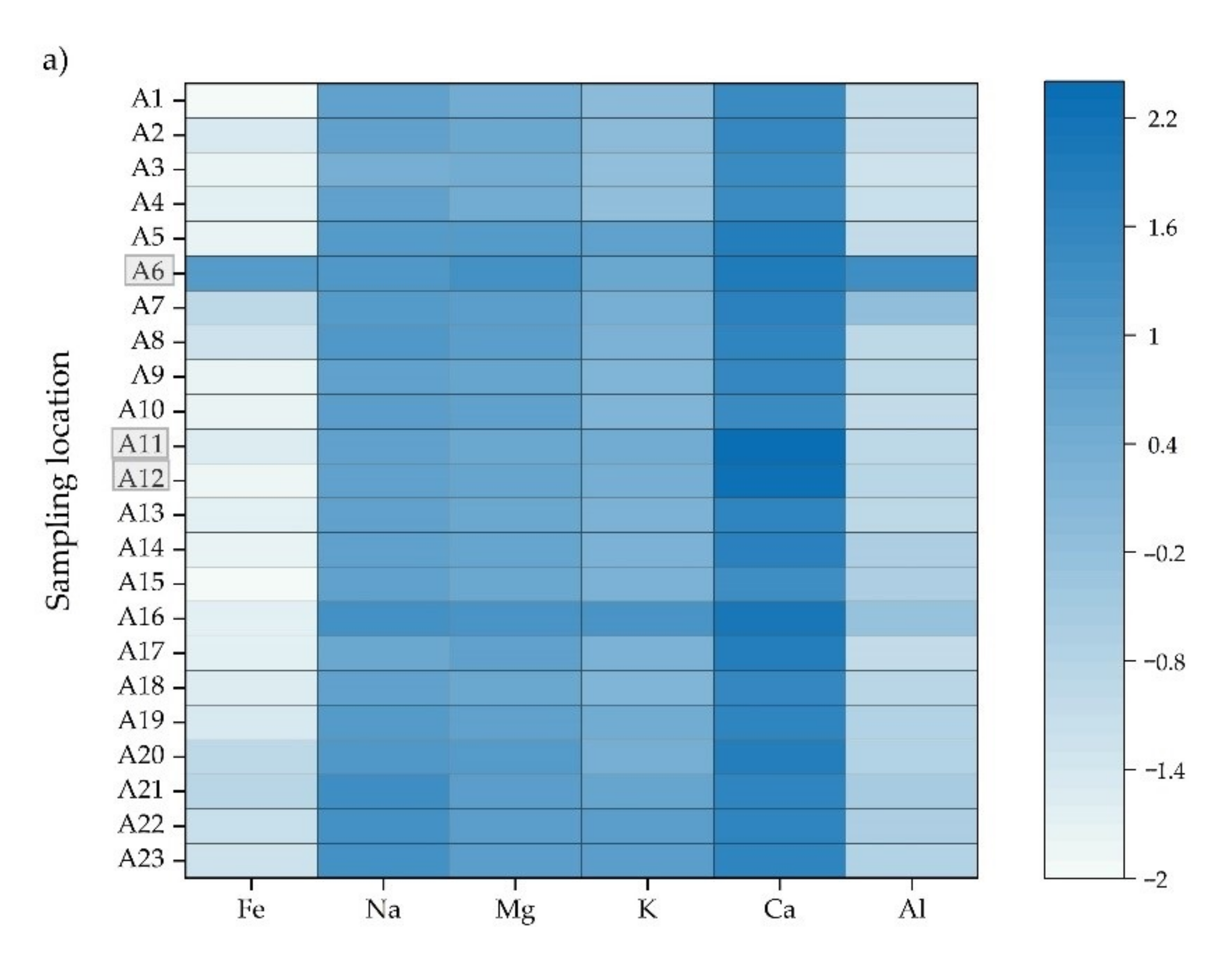
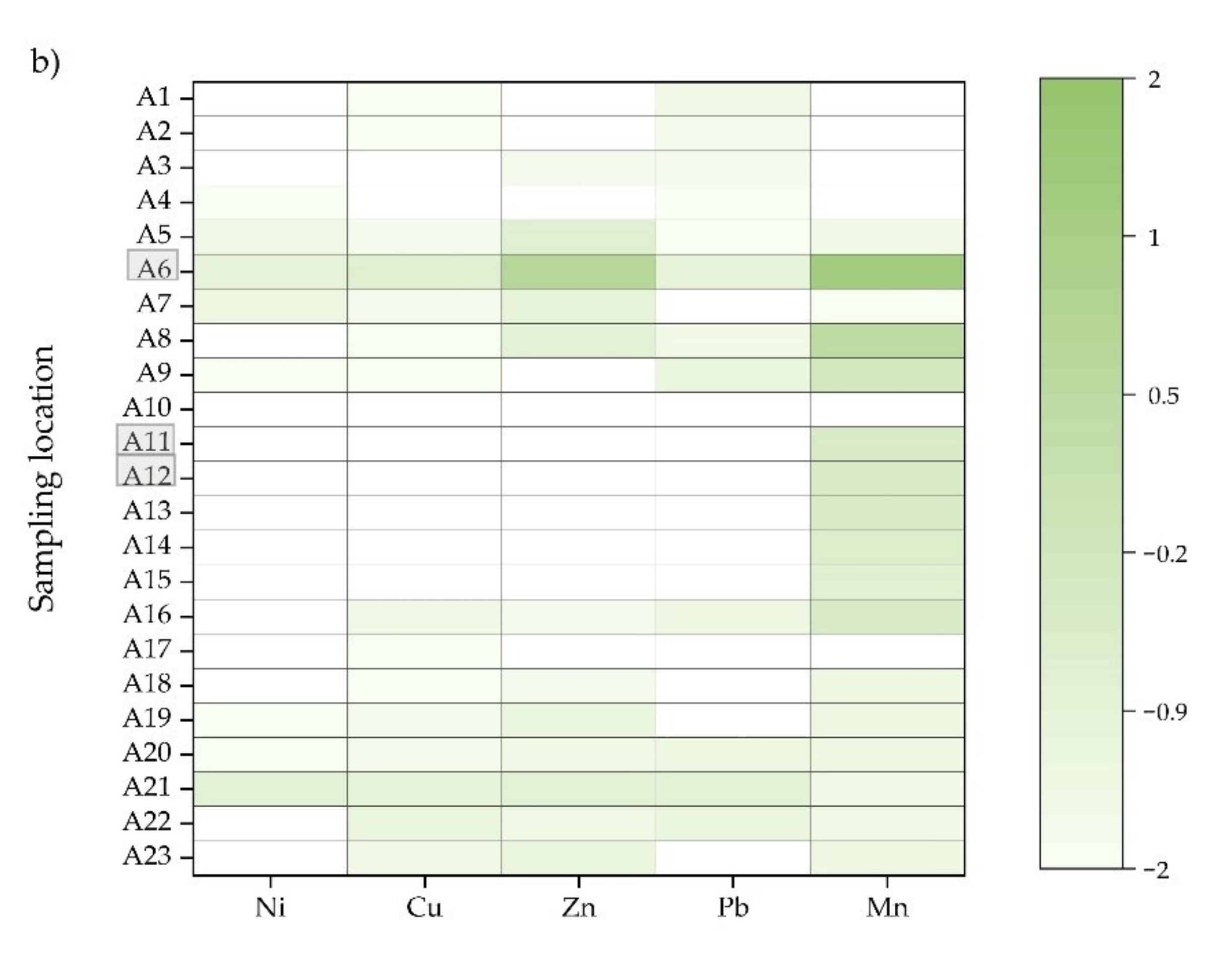
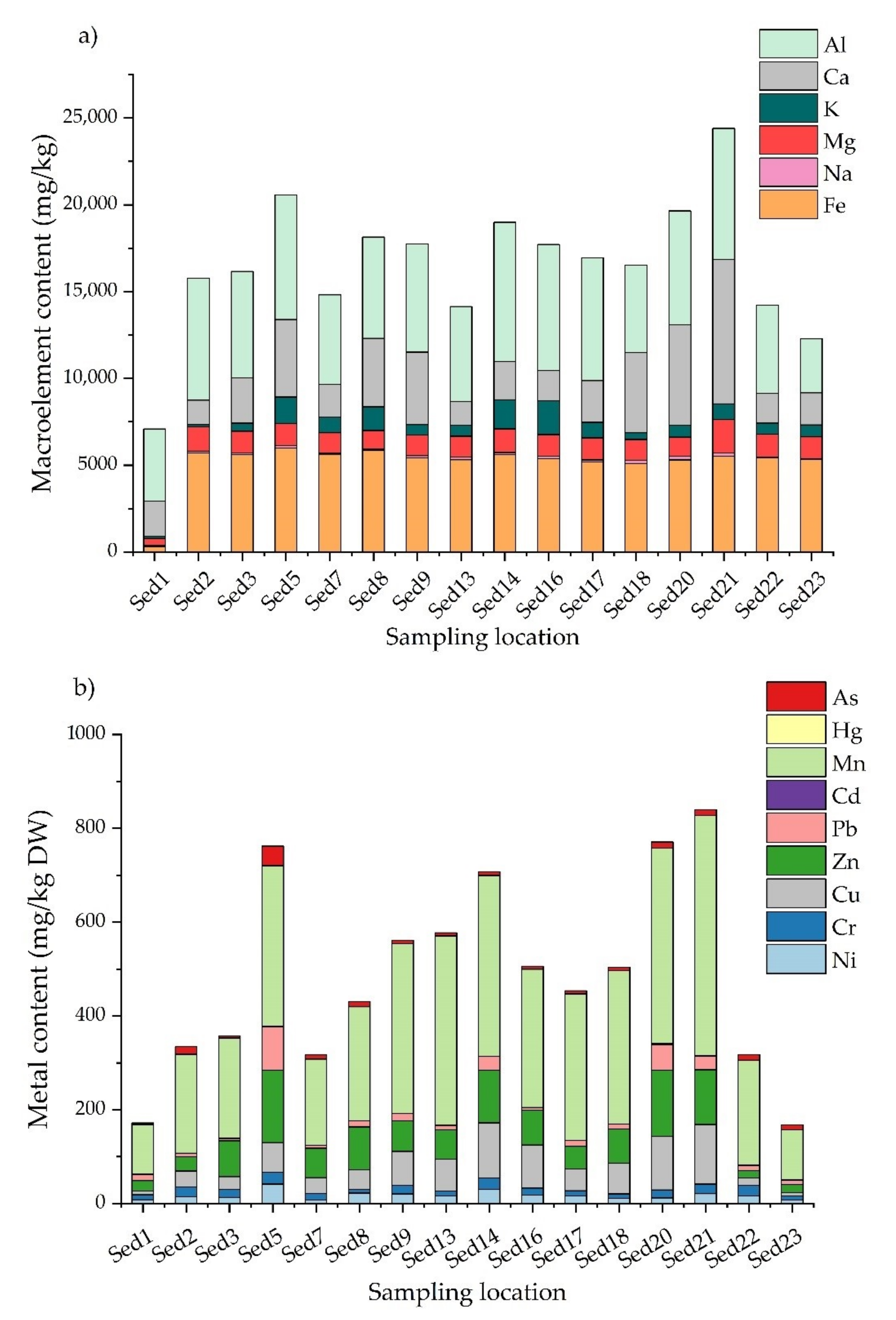
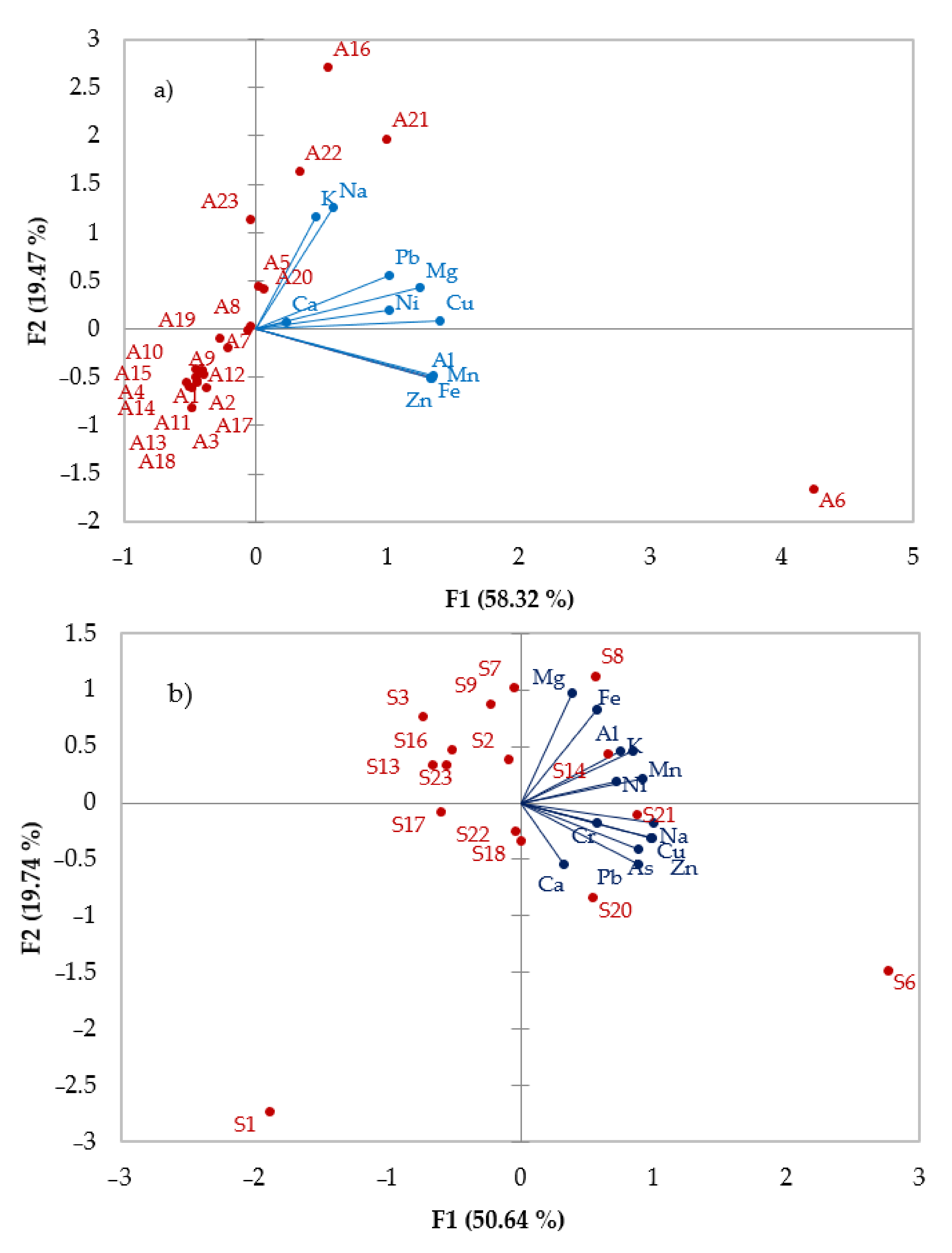
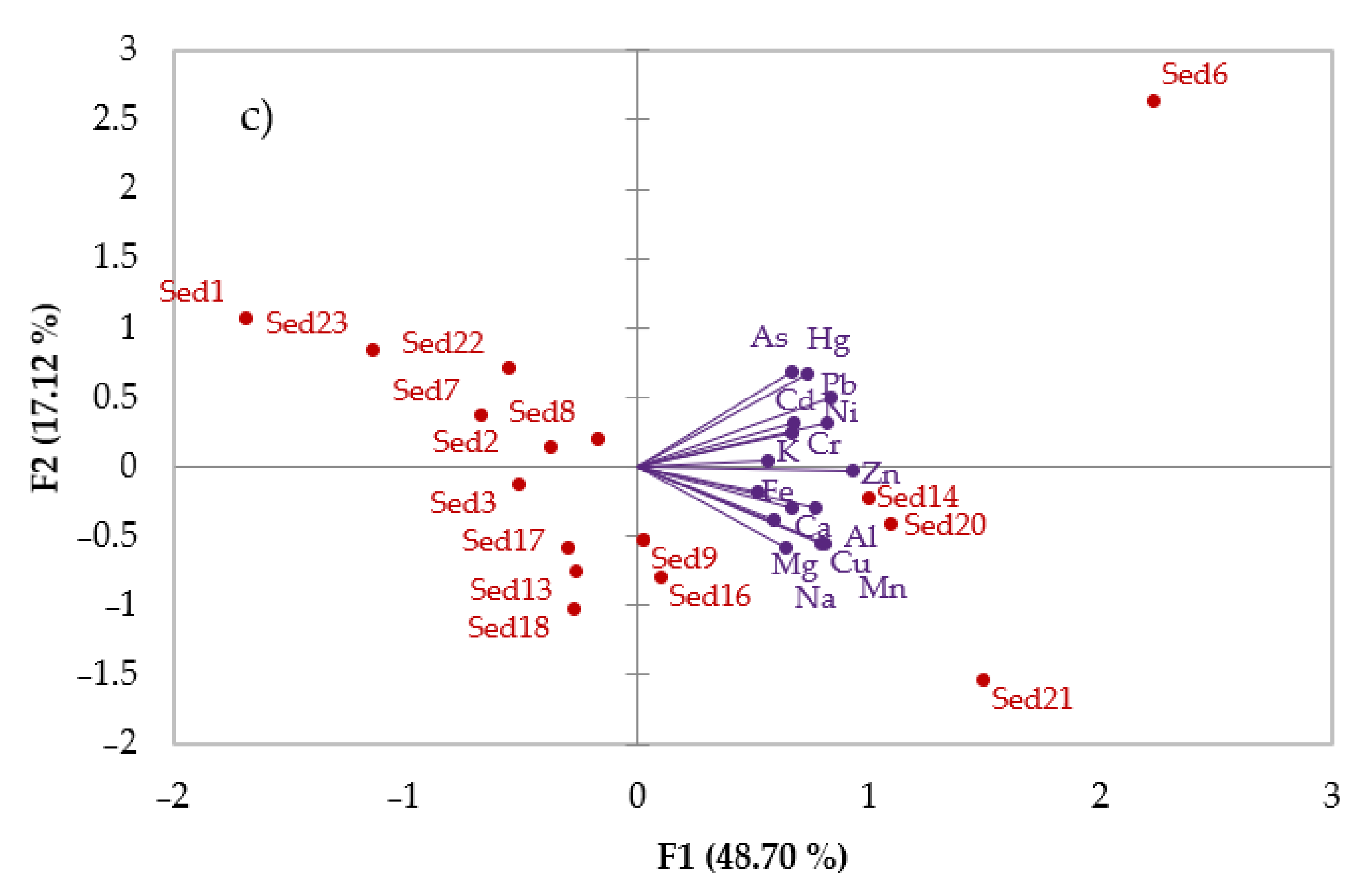

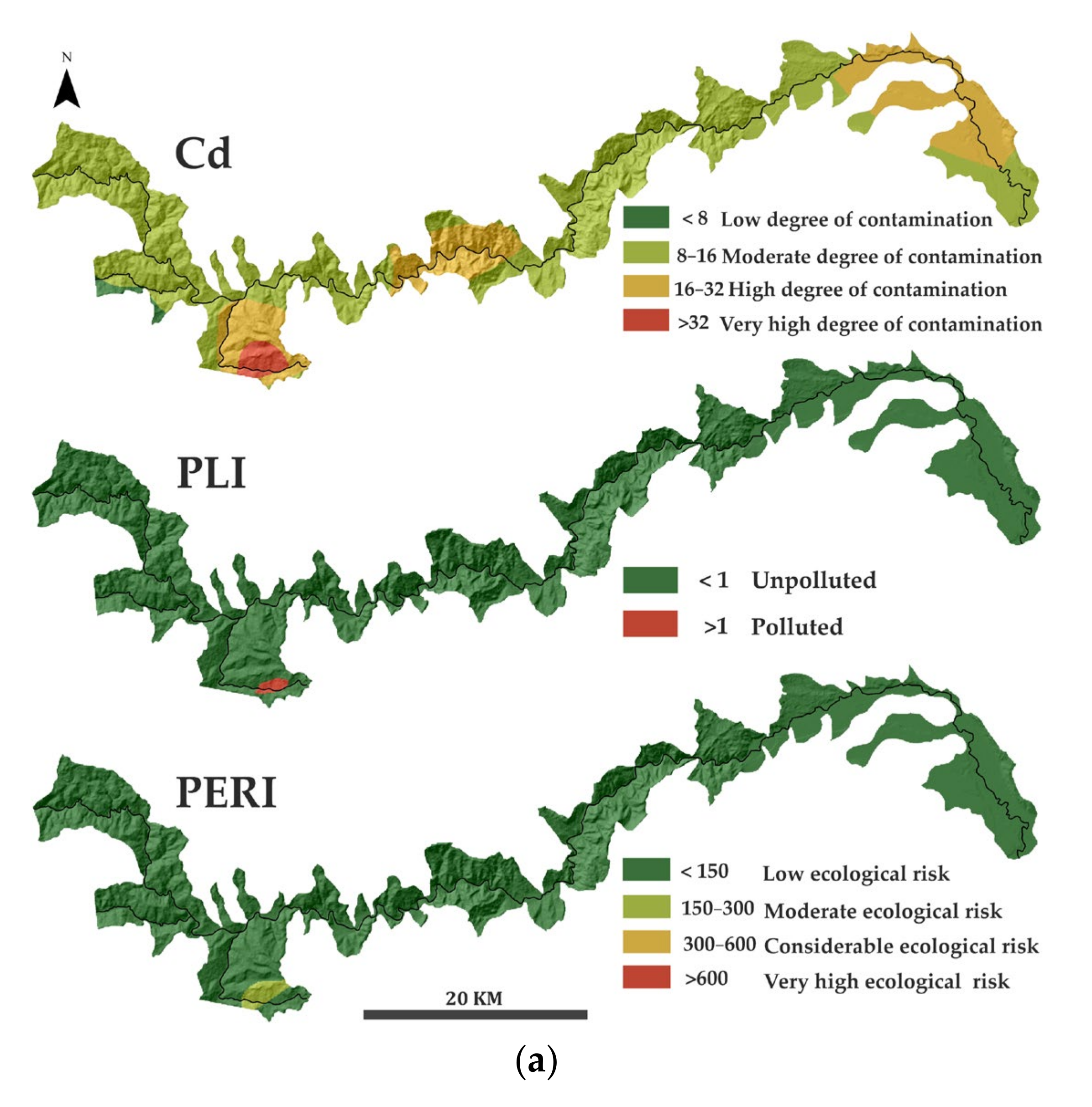

| Mining Sites | Deposit Type | Tailing Pond | Associated Water Course |
|---|---|---|---|
| Roșia Montană | Au, Ag and Cu ores | Seliște (TP1) | Abrud River |
| Gura Roșie (TP2) | Roșia Rivulet | ||
| Roșia Poieni | Porphyritic Cu | Ștefanca (TP3) | Ștefanca Valley |
| Șesei (TP4) | Șesei Valley |
| Surface Water | Fe | Na | Mg | K | Ca | Ni | Cr | Cu | Zn | Cd | Pb | Mn | Al | As | Hg |
|---|---|---|---|---|---|---|---|---|---|---|---|---|---|---|---|
| mg/L | |||||||||||||||
| Min | 0.01 | 2.47 | 2.55 | 0.64 | 23.7 | 0.02 | - | 0.02 | 0.02 | - | 0.01 | 0.03 | 0.06 | 0.001 | - |
| Max | 8.73 | 21.4 | 18.3 | 14.7 | 219 | 0.14 | - | 0.21 | 4.22 | 0.05 | 0.15 | 22.4 | 22.8 | 0.003 | - |
| Mean | 0.44 | 9.10 | 6.00 | 3.08 | 63.66 | 0.04 | - | 0.04 | 0.37 | 0.02 | 0.05 | 1.62 | 1.16 | 0.002 | - |
| SD | 1.85 | 5.33 | 3.76 | 3.10 | 48.04 | 0.03 | - | 0.04 | 1.11 | 0.02 | 0.04 | 5.38 | 4.72 | 0.001 | - |
| CV | 4.24 | 0.59 | 0.63 | 1.01 | 0.75 | 0.91 | - | 0.99 | 2.97 | 1.07 | 0.70 | 3.32 | 4.06 | 0.42 | - |
| NT | RN * | RN | RN | RN | RN | RN | - | RN | RN | RN | RN | RN | RN | RN | - |
| Soil | Fe | Na | Mg | K | Ca | Ni | Cr | Cu | Zn | Cd | Pb | Mn | Al | As | Hg |
| mg/kg | |||||||||||||||
| Min | 529 | 6.9 | 967 | 205 | 2316 | 22.5 | 16.5 | 22.4 | 92.4 | - | 19.5 | 61.1 | 743 | 0.072 | 0.10 |
| Max | 11,362 | 578 | 2547 | 3164 | 11,842 | 105 | 64.4 | 512 | 612 | - | 308 | 1228 | 19,797 | 0.824 | 1.51 |
| Mean | 9475 | 216 | 2135 | 1912 | 6749 | 43.1 | 36.7 | 127 | 242 | - | 62 | 779 | 12,590 | 0.24 | 0.30 |
| SD | 2484 | 133 | 364 | 727 | 3662 | 22 | 13 | 124 | 145 | - | 74 | 294 | 5520 | 0.17 | 0.37 |
| CV | 0.26 | 0.62 | 0.17 | 0.38 | 0.54 | 0.52 | 0.35 | 0.97 | 0.60 | - | 1.19 | 0.38 | 0.44 | 0.70 | 1.23 |
| NT | RN | CRN * | RN | CRN | RN | RN | CRN | RN | RN | - | RN | CRN | CRN | RN | RN |
| Sediment | Fe | Na | Mg | K | Ca | Ni | Cr | Cu | Zn | Cd | Pb | Mn | Al | As | Hg |
| mg/kg | |||||||||||||||
| Min | 314 | 48.3 | 412 | 112 | 1367 | 7.08 | 8.22 | 7.22 | 15.6 | 0.03 | 5.22 | 106 | 3106 | 3.11 | 0.02 |
| Max | 5982 | 207 | 1913 | 1950 | 8308 | 41.6 | 25.5 | 127 | 154 | 2.0 | 92.6 | 512 | 8022 | 40.7 | 0.91 |
| Mean | 5165 | 117 | 1229 | 848 | 3155 | 17.3 | 15.8 | 58.3 | 72.7 | 0.47 | 20.3 | 290.4 | 6054 | 10.7 | 0.16 |
| SD | 1316 | 55 | 288 | 534 | 1928 | 8.94 | 5.7 | 39 | 42 | 0.69 | 23 | 114 | 1332 | 8.70 | 0.22 |
| CV | 0.25 | 0.47 | 0.23 | 0.63 | 0.61 | 0.52 | 0.36 | 0.66 | 0.58 | 1.47 | 1.14 | 0.39 | 0.22 | 0.81 | 1.39 |
| NT | RN * | CRN | RN | CRN | RN | RN | CRN | CRN | CRN | RN | RN | CRN | CRN | RN | RN |
| Matrix | Element | Reference | |||||||||||||
|---|---|---|---|---|---|---|---|---|---|---|---|---|---|---|---|
| Fe | Al | Mn | Ni | Cu | Pb | As | Cd | Cr | Zn | Ca | K | Mg | Na | ||
| Water (mg/L) | - | - | 7.67 | - | 0.28 | - | - | - | - | - | 46.9 | 2.26 | 6.76 | 7.16 | [20] |
| 0.298 | - | - | - | 0.0001 | - | - | - | - | - | - | - | - | - | [61] | |
| 0.124 | 0.091 | 0.143 | 0.062 | 0.093 | 0.102 | 0.003 | 0.026 | 0.036 | 0.044 | 56.0 | 2.96 | 6.99 | 7.77 | [23] | |
| 1.311 | - | 0.133 | 0.013 | 0.063 | 0.028 | - | 0.014 | - | 0.038 | 20.1 | 1.0 | 2.6 | 2.8 | [62] | |
| 0.751 | - | 1.54 | - | 0.352 | - | - | - | - | 0.145 | - | - | - | - | [63] | |
| - | - | - | - | 0.472 | 0.002 | - | 0.059 | 0.155 | 5.33 | - | - | - | - | [64] | |
| - | - | - | - | 0.013 | 0.001 | - | - | - | 0.154 | - | - | - | - | [65] | |
| 1.39 | 0.65 | - | - | 0.04 | 0.02 | - | - | - | 0.23 | - | - | - | - | [66] | |
| Soil (mg/kg) | - | - | - | - | - | 104 | 114 | <0.0008 | 22.1 | - | - | - | - | - | [67] |
| - | - | - | - | 44.1 | 116 | - | - | 42.2 | - | - | - | - | - | [68] | |
| Sediment (mg/kg) | 17,630 | 15,708 | 842 | 25.4 | 160 | 25.9 | 14.6 | 0.827 | 20.8 | 224 | 5738 | 2214 | 7491 | 175 | [22] |
| - | - | - | - | 338 | 65.9 | 41.9 | 1.71 | - | 366 | - | - | - | - | [27] | |
| - | - | - | 155 | 51.2 | 45.7 | 12.9 | 0.610 | 51.7 | 33.20 | - | - | - | - | [69] | |
Publisher’s Note: MDPI stays neutral with regard to jurisdictional claims in published maps and institutional affiliations. |
© 2022 by the authors. Licensee MDPI, Basel, Switzerland. This article is an open access article distributed under the terms and conditions of the Creative Commons Attribution (CC BY) license (https://creativecommons.org/licenses/by/4.0/).
Share and Cite
Moldovan, A.; Török, A.I.; Kovacs, E.; Cadar, O.; Mirea, I.C.; Micle, V. Metal Contents and Pollution Indices Assessment of Surface Water, Soil, and Sediment from the Arieș River Basin Mining Area, Romania. Sustainability 2022, 14, 8024. https://doi.org/10.3390/su14138024
Moldovan A, Török AI, Kovacs E, Cadar O, Mirea IC, Micle V. Metal Contents and Pollution Indices Assessment of Surface Water, Soil, and Sediment from the Arieș River Basin Mining Area, Romania. Sustainability. 2022; 14(13):8024. https://doi.org/10.3390/su14138024
Chicago/Turabian StyleMoldovan, Ana, Anamaria Iulia Török, Eniko Kovacs, Oana Cadar, Ionuț Cornel Mirea, and Valer Micle. 2022. "Metal Contents and Pollution Indices Assessment of Surface Water, Soil, and Sediment from the Arieș River Basin Mining Area, Romania" Sustainability 14, no. 13: 8024. https://doi.org/10.3390/su14138024
APA StyleMoldovan, A., Török, A. I., Kovacs, E., Cadar, O., Mirea, I. C., & Micle, V. (2022). Metal Contents and Pollution Indices Assessment of Surface Water, Soil, and Sediment from the Arieș River Basin Mining Area, Romania. Sustainability, 14(13), 8024. https://doi.org/10.3390/su14138024








